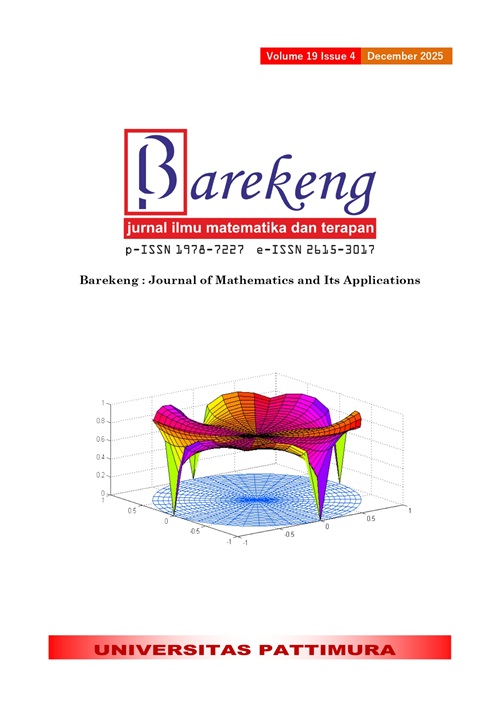A BINARY INTEGER LINEAR PROGRAMMING MODEL FOR EMPLOYEE SCHEDULING IN A CONVENIENCE STORE: A CASE STUDY IN NAKHON PATHOM
Abstract
Convenience stores are workplaces where employees work in shifts. An optimal work schedule for employees is necessary for every convenience store because it enables employees to work more efficiently. This paper considers the employee scheduling of a 24-hour convenience store in Nakhon Pathom. This store divides working hours into three shifts: morning, noon, and night. Each employee is assigned to the same shift for an entire week before rotating to a different shift in the next week. This paper presents a novel binary integer linear programming model for generating an optimal four-week employee schedule for this convenience store. The objective of the proposed model was to prioritize assigning weekend days off to the manager and assistant managers ahead of the regular staff, while adhering to the constraints outlined in the store’s regulations. The proposed model was solved using the CPLEX software to generate an optimal schedule for the 15 employees at this convenience store. The model could find an optimal schedule with a computational time of less than three seconds, where the days off for the manager and assistant managers could all be scheduled on weekends. The proposed model also verified that the current number of employees at the convenience store is the minimum required to create a feasible work schedule, and the store needs to increase its staff by at least two employees if each employee is to work the night shift for at most one week within a four-week schedule period. The proposed model can be a practical tool for generating an optimal employee schedule for this convenience store in real-life scenarios.
Downloads
References
A. T. Ernst, H. Jiang, M. Krishnamoorthy, and D. Sier, “STAFF SCHEDULING AND ROSTERING: A REVIEW OF APPLICATIONS, METHODS AND MODELS,” Eur J Oper Res, vol. 153, no. 1, pp. 3–27, 2004, doi: https://doi.org/10.1016/S0377-2217(03)00095-X.
J. Van den Bergh, J. Beliën, P. De Bruecker, E. Demeulemeester, and L. De Boeck, “PERSONNEL SCHEDULING: A LITERATURE REVIEW,” Eur J Oper Res, vol. 226, no. 3, pp. 367–385, 2013, doi: https://doi.org/10.1016/j.ejor.2012.11.029.
I. Castillo, T. Joro, and Y. Y. Li, “WORKFORCE SCHEDULING WITH MULTIPLE OBJECTIVES,” Eur J Oper Res, vol. 196, no. 1, pp. 162–170, 2009, doi: https://doi.org/10.1016/j.ejor.2008.02.038.
J. Mongkhonsang, A. Pho-on, and S. Chanta, “SHIFT WORK SCHEDULING FOR CONVENIENT STORE CASHIERS USING MATHEMATICAL MODEL,” in Operations Research Network Conference 2017, 2017, p. 39.
W. Sintunavarat, K. Tangsamphan, J. Wongthitaporn, and P. Atthakarnpong, “THE APPLICATION OF QUEUING THEORY TO MINIMIZE THE TOTAL COST FOR EMPLOYEES SCHEDULING PROBLEMS: A CASE STUDY OF 7-ELEVEN AT INTER ZONE, THAMMASAT UNIVERSITY RANGSIT CENTER,” in Operations Research Network Conference 2019, 2019, pp. 307–314.
D. Lin et al., “SCHEDULING WORKFORCE FOR RETAIL STORES WITH EMPLOYEE PREFERENCES,” in 2015 IEEE International Conference on Service Operations And Logistics, And Informatics (SOLI), IEEE, 2015, pp. 37–42. doi: https://doi.org/10.1109/SOLI.2015.7367407.
N. Gusmeroli and A. Bettinelli, “A MIXED-INTEGER LINEAR PROGRAM TO CREATE THE SHIFTS IN A SUPERMARKET,” arXiv preprint arXiv:2403.17850, 2024.
S. N. S. Ahamad and N. H. A. Ghani, “A BINARY INTEGER PROGRAMMING MODEL FOR PERSONNEL SCHEDULING: A CASE STUDY AT FAST-FOOD RESTAURANT IN JOHOR,” Journal of Advanced Research in Applied Sciences and Engineering Technology, vol. 30, no. 3, pp. 334–347, 2023, doi: https://doi.org/10.37934/araset.30.3.334347.
D. S. M. Nasir, N. D. A. Sabri, N. H. Shafii, and S. Abu Hasan, “SHIFT SCHEDULING WITH THE GOAL PROGRAMMING APPROACH IN FAST-FOOD RESTAURANT: MCDONALD’S IN KELANTAN,” Journal of Computing Research and Innovation, vol. 7, no. 1, pp. 104–112, 2022, doi: https://doi.org/10.24191/jcrinn.v7i1.279.
B. A. Kassa and A. E. Tizazu, “PERSONNEL SCHEDULING USING AN INTEGER PROGRAMMING MODEL- AN APPLICATION AT AVANTI BLUE-NILE HOTELS,” Springerplus, vol. 2, no. 1, p. 333, 2013, doi: 10.1186/2193-1801-2-333.doi: https://doi.org/10.1186/2193-1801-2-333
Y. Yothee and R. Bojaras, “NURSE SCHEDULING MODEL BY INTEGER LINEAR PROGRAMMING A CASE STUDY: THE FORT SUNPASITTHIPRASONG HOSPITAL,” Thai Journal of Operations Research, vol. 7, no. 2, pp. 20–29, 2019.
M. Widyastiti, A. Aman, and T. Bakhtiar, “NURSES SCHEDULING BY CONSIDERING THE QUALIFICATION USING INTEGER LINEAR PROGRAMMING,” TELKOMNIKA (Telecommunication Computing Electronics and Control), vol. 14, no. 3, pp. 933–940, 2016, doi: https://doi.org/10.12928/telkomnika.v14i3.2913.
S. M. Al-Yakoob and H. D. Sherali, “MIXED-INTEGER PROGRAMMING MODELS FOR AN EMPLOYEE SCHEDULING PROBLEM WITH MULTIPLE SHIFTS AND WORK LOCATIONS,” Ann Oper Res, vol. 155, no. 1, pp. 119–142, 2007, doi: https://doi.org/10.1007/s10479-007-0210-4.
S. M. Al-Yakoob and H. D. Sherali, “A COLUMN GENERATION APPROACH FOR AN EMPLOYEE SCHEDULING PROBLEM WITH MULTIPLE SHIFTS AND WORK LOCATIONS,” Journal of the Operational Research Society, vol. 59, no. 1, pp. 34–43, 2008, doi: https://doi.org/10.1057/palgrave.jors.2602294.
S. Ağralı, Z. C. Taşkın, and A. T. Ünal, “EMPLOYEE SCHEDULING IN SERVICE INDUSTRIES WITH FLEXIBLE EMPLOYEE AVAILABILITY AND DEMAND,” Omega (Westport), vol. 66, pp. 159–169, 2017, doi: https://doi.org/10.1016/j.omega.2016.03.001.
A. Batista, A. Senapati, M. Davoodi, and J. M. Calabrese, “PERSONNEL STAFFING AND SCHEDULING DURING DISEASE OUTBREAKS: A CONTACT NETWORK-BASED ANALYSIS,” Comput Ind Eng, vol. 193, p. 110112, Jul. 2024, doi: https://doi.org/10.1016/j.cie.2024.110112.
S. Y. Ang, S. N. A. Mohd Razali, and S. L. Kek, “OPTIMIZED PREFERENCE OF SECURITY STAFF SCHEDULING USING INTEGER LINEAR PROGRAMMING APPROACH,” COMPUSOFT: An International Journal of Advanced Computer Technology, vol. 8, no. 4, pp. 3103–3111, 2019.
P. Cappanera et al., “INTEGRATED TASK SCHEDULING AND PERSONNEL ROSTERING OF AIRPORTS GROUND STAFF: A CASE STUDY,” Expert Syst Appl, vol. 238, p. 121953, Mar. 2024, doi: https://doi.org/10.1016/j.eswa.2023.121953.
N. Xue, R. Bai, D. Landa-Silva, T. Cui, and H. Jin, “A TWO-PHASE APPROACH FOR SOLVING THE MULTI-SKILLED AND IRREGULAR PERSONNEL SCHEDULING PROBLEM,” Jun. 04, 2024. doi: https://doi.org/10.21203/rs.3.rs-4449906/v1.
A. Amindoust, M. Asadpour, and S. Shirmohammadi, “A HYBRID GENETIC ALGORITHM FOR NURSE SCHEDULING PROBLEM CONSIDERING THE FATIGUE FACTOR,” J Healthc Eng, vol. 2021, pp. 1–11, 2021, doi: https://doi.org/10.1155/2021/5563651.
S. Ceschia, L. Di Gaspero, V. Mazzaracchio, G. Policante, and A. Schaerf, “SOLVING A REAL-WORLD NURSE ROSTERING PROBLEM BY SIMULATED ANNEALING,” Oper Res Health Care, vol. 36, p. 100379, 2023, doi: https://doi.org/10.1016/j.orhc.2023.100379.
A. Muklason et al., “SOLVING NURSE ROSTERING OPTIMIZATION PROBLEM USING REINFORCEMENT LEARNING - SIMULATED ANNEALING WITH REHEATING HYPER-HEURISTICS ALGORITHM,” Procedia Comput Sci, vol. 234, pp. 486–493, 2024, doi: https://doi.org/10.1016/j.procs.2024.03.031.
E. Gülmez, H. I. Koruca, M. E. Aydin, and K. B. Urganci, “HEURISTIC AND SWARM INTELLIGENCE ALGORITHMS FOR WORK-LIFE BALANCE PROBLEM,” Comput Ind Eng, vol. 187, p. 109857, Jan. 2024, doi: https://doi.org/10.1016/j.cie.2023.109857.
M. Günther and V. Nissen, “PARTICLE SWARM OPTIMIZATION AND AN AGENT-BASED ALGORITHM FOR A PROBLEM OF STAFF SCHEDULING,” in Applications of Evolutionary Computation. EvoApplications 2010, Lecture Notes in Computer Science, vol 6025, Springer, Berlin, Heidelberg, 2010, pp. 451–461.doi: https://doi.org/10.1007/978-3-642-12242-2_46
O. S. S. T. Edleston and L. M. Bartlett, “A TABU SEARCH ALGORITHM APPLIED TO THE STAFFING ROSTER PROBLEM OF LEICESTERSHIRE POLICE FORCE,” Journal of the Operational Research Society, vol. 63, no. 4, pp. 489–496, 2012, doi: https://doi.org/10.1057/jors.2011.44.
Y. Xu and X. Wang, “A HYBRID INTEGER PROGRAMMING AND ARTIFICIAL BEE COLONY ALGORITHM FOR STAFF SCHEDULING IN CALL CENTERS,” Comput Ind Eng, vol. 171, p. 108312, 2022, doi: https://doi.org/10.1016/j.cie.2022.108312.
R. Wang, Y. Xu, and X. Wang, “SHIFT SCHEDULING AND ROSTERING WITH SAME SHIFT-TYPE AND WEEKEND-OFF FAIRNESS CONSTRAINTS IN CALL CENTRES,” European J. of Industrial Engineering, vol. 19, no. 3, pp. 340–373, 2025, doi: https://doi.org/10.1504/EJIE.2025.145292.
A. Bansal, K. P. Anoop, and N. Rangaraj, “HEURISTIC FOR RAILWAY CREW SCHEDULING WITH CONNECTIVITY OF SCHEDULES,” Transportation Research Record: Journal of the Transportation Research Board, vol. 2678, no. 8, pp. 873–887, Aug. 2024, doi: https://doi.org/10.1177/03611981231223190.
B.T.C. van Rossum, T. Dollevoet, and D. Huisman, “BENDERS DECOMPOSITION FOR ROBUST TACTICAL RAILWAY CREW SCHEDULING,” arXiv preprint arXiv:2410.06382, 2024.
Z. Zainudin et al., “AN INTELLIGENT OPTIMIZATION STRATEGY FOR MEDICAL DOCTOR ROSTERING USING HYBRID GENETIC ALGORITHM-PARTICLE SWARM OPTIMIZATION IN MALAYSIAN PUBLIC HOSPITAL,” Malaysian Journal of Fundamental and Applied Sciences, vol. 21, no. 1, pp. 1642–1653, Feb. 2025, doi: https://doi.org/10.11113/mjfas.v21n1.3572.
F. S. Hillier and G. J. Lieberman, INTRODUCTION TO OPERATIONS RESEARCH, 9th ed. New York, USA: McGraw-Hill, 2009.
Copyright (c) 2025 Teeradech Laisupannawong, Chawalit Jeenanunta

This work is licensed under a Creative Commons Attribution-ShareAlike 4.0 International License.
Authors who publish with this Journal agree to the following terms:
- Author retain copyright and grant the journal right of first publication with the work simultaneously licensed under a creative commons attribution license that allow others to share the work within an acknowledgement of the work’s authorship and initial publication of this journal.
- Authors are able to enter into separate, additional contractual arrangement for the non-exclusive distribution of the journal’s published version of the work (e.g. acknowledgement of its initial publication in this journal).
- Authors are permitted and encouraged to post their work online (e.g. in institutional repositories or on their websites) prior to and during the submission process, as it can lead to productive exchanges, as well as earlier and greater citation of published works.






1.gif)



